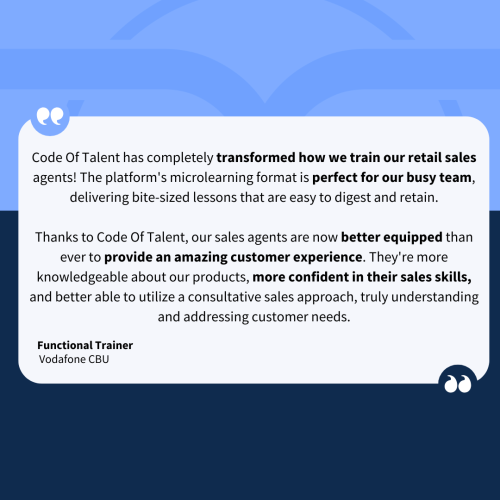ROI. The dreaded word in the corporate world. Whether it’s about marketing, sales, or learning and development (L&D), executives demand immediate, tangible results, including ROI (return on investment). While other specialties have a multitude of tools to track ROI and refine their strategies, L&D teams are often left in the dark. Training is notoriously difficult to track, measure, and translate into quantifiable numbers. And when it comes to B2B sales training, explaining a disappointing training ROI to executives can weaken support for the program.
With organizations spending an average of $2,020 per salesperson annually for their training, is this hefty investment worth it? L&D leaders will argue that training is essential, regardless of the specialty. But executives speak the language of numbers, and ROI is the ultimate metric that justifies any investment.
This article will examine how companies can reduce B2B sales training costs without compromising effectiveness. In fact, they may even improve it. The key is microlearning, a more efficient approach to delivering training.
Calculating ROI of B2B Sales Training (or Any Training)
Despite its fancy terminology and eyebrow-raising acronym, ROI simply translates to how much you’re getting back for your investment. It’s a percentage that helps businesses measure the return on their spending. The higher the number, the better the return.
The formula for ROI in sales training is:
ROI = (Benefits from sales training – Training costs)/ Training costs x 100
Example: If a company spends $100,000 on B2B sales training and generates $300,000 in additional sales, the ROI would be:
ROI = (300,000 – 100,000) / 100,000 × 100 = 200%
This means for every dollar spent on training, the company earned two dollars in return, resulting in a 200% ROI.
Why Traditional B2B Sales Training is Falling Behind
When it comes to delivering measurable results, traditional B2B sales training methods often fall short. Tactics such as lengthy, one-size-fits-all courses, generic sales methodologies, and one-time workshops fail to address the specific needs of sales teams.
Several factors contribute to this struggle:
- Overwhelming, Lengthy Courses: Traditional training programs are packed with excessive information that isn’t immediately useful, making it hard for sales reps to retain and apply key lessons.
- Generic Sales Methodologies: Many training programs focus on broad sales tactics instead of industry-specific strategies. B2B reps need training tailored to their complex sales cycles, multi-stakeholder negotiations, and long-term relationship building.
- Lack of Reinforcement: One-time workshops don’t provide ongoing support. Without reinforcement, salespeople quickly forget key concepts.
- Disconnect from Real-Life Situations: B2B reps often lack training in crucial soft skills like client engagement, conflict resolution, and objection handling, which are essential in high-stakes negotiations and maintaining long-term partnerships.
- Insufficient Product & Client Training: B2B sales require deep product knowledge and an understanding of how solutions fit into a client’s business operations. Traditional training often fails to provide this level of detail.
- No Cross-Departmental Awareness: Sales teams don’t operate in isolation. As Harvard Business Review notes, while they don’t need to master other roles, salespeople must understand how other departments affect the sales process and customers. However, traditional training rarely covers topics beyond sales, leaving reps unprepared for the job’s complexities.
Microlearning as a Solution
With people forgetting 80% of what they learned within a month, the average attention shrinking to 8.25 seconds, and the younger generations of employees disengaged from training, a new approach to learning entered the scene in the past few years.
Microlearning involves breaking down content into small chunks (no longer than 7 minutes), often delivered in the form of short videos, interactive modules, or quick read-ups. Microlearning platforms have populated the L&D scene and have been proven to be highly effective, including B2B sales training.
B2B sales teams need training that is practical, flexible, and easy to retain. Microlearning meets these demands by delivering the right amount of information at the right time. For example, a rep can quickly access a short module to refresh their knowledge about a client or a product update before a sales pitch.
Microlearning is all about adaptability, agility, and effectiveness. Here’s why:
Instant Application
Microlearning allows employees to immediately apply what they’ve learned, reducing the time between training and real-world execution. This is crucial for a sales team that needs to stay agile and responsive to customer demands.
Continuous Learning
With microlearning, employees can access targeted lessons whenever they face a specific challenge. This makes it easier for salespeople to get the information they need, when they need it, without waiting for another lengthy training session.
Spaced Repetition for Better Retention
Research shows that people retain information better when it’s spaced out over time. Microlearning uses this method to increase retention by delivering lessons in smaller doses and revisiting key concepts regularly.
AI-Powered Adaptability
Many microlearning platforms integrate AI to generate personalized learning paths, suggest relevant content, and adapt training based on a salesperson’s progress.
Mobile Accessibility
Sales reps are constantly on the move, and microlearning platforms are designed with mobile accessibility in mind. Training can be accessed anytime, anywhere, whether on a phone, tablet, or laptop.
Multi-Language Support
Global B2B sales teams benefit from microlearning platforms offering training in multiple languages.
Interactive Learning & Dialogue
Microlearning platforms encourage engagement through direct interaction between trainers and trainees. Features like discussion boards, real-time feedback, and collaborative exercises keep employees actively involved in the learning process.
Cost-Effective
Microlearning is less expensive than traditional training. Companies can significantly reduce the overall cost of training while delivering the most relevant information to their employees.
How Microlearning Cuts Costs in B2B Sales Training
In 2024, U.S. businesses spent $98 billion on training, with approximately 5% of that budget allocated to sales training. As organizations look to get the most out of their training dollars, it’s important to consider the costs associated with both traditional training methods and microlearning solutions.
1. External Sales Training Providers
Traditional Cost: External providers can charge anywhere from $400 to $3,000 per participant for reputable programs.
Microlearning Solution: Microlearning platforms typically offer affordable subscription models or pay-per-use options, significantly lowering the per-user cost. On average, subscription models range from $5 to $15 per user per month, while pay-per-use models can cost between $1 and $5 per user per module. For enterprises, costs vary depending on the size of the organization and the service package selected.
2. Internal Training Expenditures
Traditional Cost: According to TrainingMag’s 2024 training report, training expenditures reached $25 billion, including costs for travel, training facilities, in-house training development, and equipment.
Microlearning Solution: As microlearning is delivered digitally, there are no additional costs for travel, accommodation, or venue bookings. Internal training development thus reduces to L&D teams creating, managing, and updating training in a secure, fast-paced environment. This lifts the burden placed on L&D reps by eliminating the need for time-consuming logistics.
3. Live Workshops & Coaching
Traditional Cost: Multi-day workshops and coaching sessions can cost tens of thousands of dollars due to travel, venue, and other logistical expenses. For example, travel and accommodation costs alone can range from $5,000 to $20,000 per participant, depending on the location and duration of the training. Additionally, venue rental, meals, and facilitator fees can push the total cost of a multi-day event into the $30,000 to $100,000+ range for a group of 20-30 employees.
Microlearning Solution: With microlearning, training is available on-demand, removing the need for live events and cutting down on travel and venue costs. Teams from all over the world can access the same training content at the same time, making it easy for everyone to learn together.
4. Training Materials & Content
Traditional Cost: These materials can range from $10 to $50 per employee, depending on the quality and quantity of printed content. Printing, shipping, and storing physical materials further increase expenses.
Microlearning Solution: Microlearning uses digital content, cutting down on both production and distribution costs for physical materials. Digital modules and lessons are typically more affordable, with costs ranging from $1 to $10 per employee for access to a platform. Furthermore, microlearning platforms often use AI to adapt company training materials into interactive “missions” that employees can access on-demand.
5. Reps’ Time Away from Selling
Traditional Cost: Studies show that sales reps can spend an average of 33 hours in training per year, which translates to significant time away from sales activities. For entry-level employees, this can amount to around 73.4 days of lost selling opportunities, directly impacting revenue and increasing the costs of onboarding and training.
Microlearning Solution: With microlearning, training sessions are short and can be completed during breaks or between sales calls, reducing the opportunity cost of time away from selling. Additionally, microlearning accelerates onboarding, helping new hires become productive more quickly than with traditional training methods.
Leveraging Cut Costs with Sales KPI
Reducing training costs is important, but it’s equally vital that the quality of training remains high, or even improves. To track whether your B2B sales training program is delivering value, it’s essential to reevaluate your training goals and set clear KPIs such as:
- Sales growth post-training
- Increased sales rep engagement and retention
- Improved conversion rates
- Higher customer satisfaction and retention
Incorporating these KPIs into training programs on microlearning platforms ensures that training not only reduces costs but also improves the overall performance of your sales team.
Sales Training Success Story
A successful sales training story comes from the global telecommunications company Vodafone, which uses Code of Talent’s microlearning platform and has experienced impressive growth and transformation within their sales and operations team. Some of the solutions provided by Code of Talent to Vodafone were:
- Flexible Learning: Code of Talent’s microlearning platform allowed agents to consume bite-sized lessons at their own pace, fitting training seamlessly into their busy schedules.
- Improved Sales Performance: Sales agents became more knowledgeable, confident, and able to use a consultative approach, improving their customer interactions and overall field performance.
- Tracking & Accountability: The platform’s tracking and reporting tools enabled the company to monitor agent progress, ensuring certification requirements were met and enhancing training effectiveness.

Over to You
Boosting the ROI of B2B sales training doesn’t have to be a daunting challenge.
By embracing microlearning, companies can reduce costs while simultaneously improving the effectiveness of their training programs. Platforms like Code of Talent deliver training that is relevant, flexible, and effective for B2B sales teams. With the right combination of microlearning strategies and clear KPIs to measure performance, businesses can enhance the productivity and success of their sales teams without the burden of traditional, costly training methods.
Don’t settle for less—revolutionize your B2B sales training with Code of Talent today and watch your ROI soar! Try our free trial and build an efficient sales training program in just 2 minutes!
Cover photo: Freepik





